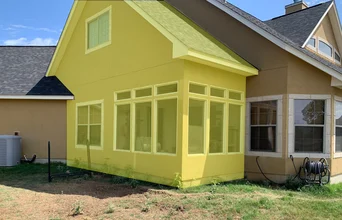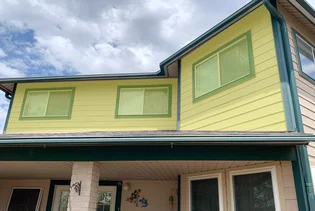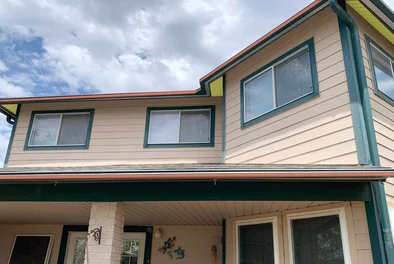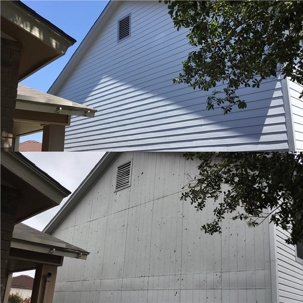On the way back from your evening stroll around the block, you glance up towards the gutters on the left side of your house and notice something doesn’t look right.
You always come around this corner and feel like you’ve seen the side of your home a million times. However, you never noticed what looks like rotted wood near the roofing.
Has it always been like that, and you’ve never noticed? Or is this a new issue with your siding that seemed to pop up overnight?
Whether it’s deterioration or damage to the siding of your home, there comes a time when it needs to be replaced. This is a large home remodeling investment, and looking at how much it costs can be daunting.
At Southwest Exteriors, we offer fiber cement siding from James Hardie. Our expert design consultants and installers know what goes into the cost and installation of a siding replacement, where your money goes, and how to get the most out of it.
A siding replacement project costs between $12,000 to $60,000. That is a wide range for a siding cost estimate, so what goes into that cost?
In this article, we will go into the five specific categories that affect the cost of your siding replacement project and why they carry the weight they do: square footage, condition of existing siding, type of siding, customizations, and recommended additions.
After reading, you will have a thorough understanding of exactly where your money goes when having your siding replaced. This is important to understand for you to be able to choose the right contractor and type of siding for your project, and it allows you to feel more comfortable in making this investment.
1. Square Footage and Design of Your Home
With most home remodeling projects, the project's size will be your most significant contributor to the cost.
However, with siding, you need to factor in how many corners there are to your siding.
When I say corners, that sounds vague. What I specifically mean is if your home has any gable or rake.
A gable is a part of your roof that sticks out from the siding.

The highlighted area is a gable. It looks like it is attached to the original frame of the house. This adds extra square footage to your siding project as opposed to a home that is flat all around.
A rake is a part of the siding that intersects with the roofing.

The highlighted area is a rake. You can see how the right side of the highlighted area intersects the roofing on the bottom. This requires more panels and cuts to the panels, creating a higher waste factor and ultimately raising the project's cost.
Many homes are not built like cardboard boxes. You can see in the design of these homes there are many corners and angled sides that require extra steps to replace the siding, which will add to your cost.
It costs more when your home has more gables and rakes because it increases the project's waste factor.
A house built like a box requires very little cutting and trimming of the siding to fit the home. With roofs and rakes, the edges start or end at an angle. This means each piece of siding must be cut to the exact angle to fit the side.
Trimming all of those pieces of siding creates a higher waste with what is cut off.
The same goes for the design of your home. If your siding goes up into a triangle shape, it will cost you more because more materials must be trimmed to fit, raising the cost and the waste factor.
To sum all of that information up, the larger the square footage of your desired siding area and the more complex the design of your home are the greatest factors that will influence the cost of your project.
2. Material of the Siding
Just like with any purchase, you have options to choose from. There are quite a few options for siding depending on the contractor you choose, but we will highlight the top four in this section, starting from least to most expensive.
Masonite and Oriented Strand Boarding
To create a synthetic material, masonite boards are made of wood fibers, wax, and other resins. It can resemble the look of wood but is not as durable and is easily susceptible to deterioration.
Similar to masonite is oriented strand boarding. This type of siding is made from wood strands compressed under high heat and pressure into layers. It is similar to plywood but about half the cost.
Both types of siding can cost around $18,000-$20,000 for 2,000 square feet of siding. This is for a standard area of square footage without gables or rake.
- Vinyl is a popular material for home improvement projects like windows and siding. It is reasonably inexpensive and works fairly well against weather and wear. It is also highly customizable to fit your desired look. Vinyl siding can cost $20,000-$23,000 for 2,000 square feet. This is for a standard area of square footage without gables or rake.
- Wood siding is a timeless option that has proven longevity and durability. You risk running into potential rotting and deterioration with anything wood, but proper inspection and care can help you avoid these problems with wood siding. Cedar and Douglas fir are the two most popular types of wood used for siding. Wood siding comes in on the more expensive side of $23,000-$25,000 for 2,000 square feet of siding. This is for a standard area of square footage without gables or rake.
- Fiber cement is made from wood fibers, sand, and cement. It is one of the most durable types of siding that will last you decades with little maintenance required. Fiber cement is also customizable to fit the look and aesthetic of your home and can also be engineered to fit your climate. A fiber cement siding is on the upper end of the siding, coming in around $35,000-$40,000 for 2,000 square feet of siding. This is for a standard area of square footage without gables or rake.
When choosing the type of material you want for your siding, it is important to factor in your goals for the project. If you are looking for the least expensive option and aren’t concerned about the material's longevity, a lower-end masonite siding might be best.
If you want to invest in a product that will last on the exterior of your home with minimal maintenance, then fiber cement might be your best option.
The square footage and design of your home and what material you want for your siding will be the top contributors to the overall cost of a project.
3. Condition of the Wall and Siding
The condition of your existing siding and substrate, or what is underneath the siding, will also affect your project's cost.
Compare it to your health and well-being. If you take care of yourself continuously throughout your life, you will likely run into fewer major health problems down the road.
The same goes for your siding. If you take care of it and do not neglect it, it will stay in much better shape for longer.
If the siding or wall is extremely deteriorated or damaged, it can cost you $2,000-$8,000 on top of the project's total cost for labor and repair.
Conversely, if your siding is in excellent condition but only needs attention in one area, that can lower your cost. Replacing a small area of a side instead of the entire side will be less expensive.
All this to say that the better condition your siding and substrate are in, the less a replacement will cost you.
4. Customizations
Depending on your chosen contractor, there is always room for customization with any home remodeling project.
With siding, you can choose the board profile, how the panel looks and is laid, and the color and texture.
There are three common types of board profiles: horizontal, vertical, and shake.
Horizontal and vertical refer to the direction the boards run, and shake siding mimics the look of wood shingles.
Within those three categories, there are different styles. For example, you can choose smooth, colonial rough, kneaded cedar mill, beaded smooth, fish scale, or staggered edge shingle.
Any of these style options can cost you 10-15% more per square foot of your project. However, a shake or shingle option can run 30-35% more.
The more complicated and elaborate the board profile, the more it will cost.
The reason shake options cost more is for the installation labor. Because shake boards are shorter than horizontal or vertical, installing them takes longer and increases labor.
Installing a few 12-foot boards would take less time and effort than installing numerous three-foot boards in the same square footage, right?
Along with customizations, there are recommended additions you include with your project to make it complete and help make it last longer.
5. Recommended Additions
Additions to your project are not necessarily customizations, but they are optional (but recommended) to your project.
On top of the siding, you can also choose to have your soffit and fascia covered with the same siding.
The soffit is the underneath area between the edge of the roof and the wall.
Fascia is the front-facing trim of the roofing.

The yellow highlight represents the soffit.
The red highlight represents the fascia.
Getting your soffit and fascia included with your siding project is recommended to add extra protection to the siding against the climate, water, and deterioration to ultimately last you longer.
You can also have your garage frame and the underside of window boxes covered with siding for the same level of extra protection.
It is important to note that fiber cement siding is the best option to cover these areas. If a different material, like vinyl, is used, it will hold moisture and dust inside rather than keeping it out.
Siding from James Hardie is best recommended to fight against the weather and last.
Painting and touching up any exterior areas, like your garage door or patio ceiling, is also recommended when replacing your siding. It is best to get all exterior done and repaired or replaced at once so you do not have to worry about it short term.
While none of these additions are required to have your siding replaced, adding extra protection to your siding and your home is recommended.
Ready to Have Your Siding Replaced?
Now, you have a better understanding of what goes into the overall cost of a siding project.
The top influencers that will affect the price are the square footage of the area, the material, the condition of the existing siding, and extra customizations or add-ons.
Southwest Exteriors offers fiber cement siding from James Hardie because it is proven to be the most popular siding brand in North America. It is durable and professional, and we want to offer you the best.
No matter what contractor or type of siding you choose, keeping your priorities and goals in mind is essential. The best product will never be the least expensive, so consider what is important to you and your home when choosing a contractor and siding.
Are you interested in learning more about Southwest Exterior siding? Schedule a free in-home consultation to get an exact quote for your project. Virtual consultations are available for your safety and comfort.

